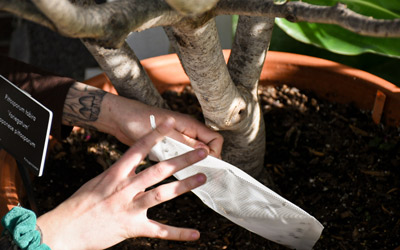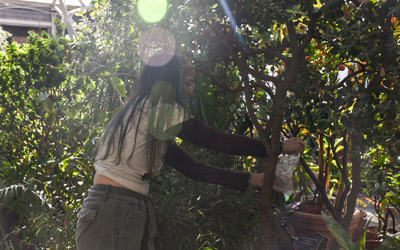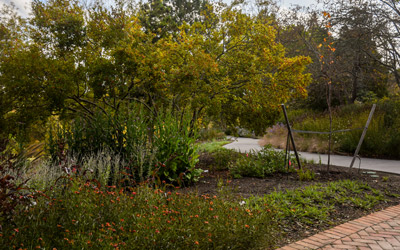Beneficials at the Garden
Insects play essential roles in our ecosystems and are important components of our gardens. In outdoor garden spaces we steward habitats for pollinators, while indoors we look to beneficial insects to help control pest populations.
Our Community of Beneficial Bugs
As a general rule of (green) thumb, the Garden only uses pesticides as a last resort. To control plant pests in a more sustainable and ecologically-friendly way, the Garden uses beneficial insects to manage conservatory pests—largely mealybugs, aphids, and spider mites—that attack and harm the plants in our collection.
One of the most common beneficials used by the Garden’s horticulture team is mealybug destroyers. A ‘cousin’ of ladybugs, these small beetles, released once a month, consume mealybugs at all life stages, helping to combat present damage while decreasing the impact of the future generations.
Any time a collection of plants is placed in a controlled environment, there is potential for an insect infestation to get out of control quickly. But due to the continued work of the horticulture team’s “conservatory crew,” the conservatories have seen a growing community of beneficial insects and a decreasing population of pests. Learn more about this thriving community at our blog and read more about these beneficial bugs below.
Mealybug Destroyer (Cryptolaemus montrouzieri)
The mealybug destroyer is a beneficial insect that horticulture staff release every month the conservatory collection is indoors. Mealybug destroyers primarily feed on mealybugs and other scale insects and are used worldwide to treat orchards and plant collections. In the same Family as ladybugs or ladybeetles (Coccinellidae), these bugs are domed-back beetles with a flat underside. To attract the mealybugs they prey on, adult mealybug destroyers will secrete a waxy coating on their wings. This strategy is known as aggressive mimicry. The optimal environment for these insects is between 65-81°F and 70% humidity or greater.
Green Lacewing (Chrysoperla rufilabris)
Green lacewings are released almost every month of the consevatory indoor season. These insects are native to the eastern U.S., and the larvae primarily feed on soft-bodied pests such as thrips, aphids, and whitefly. Adult green lacewings consume nectar and pollen from various flowers, as well as honeydew produced by plants or other pests. Green lacewings bear the nickname “Aphid Wolf,” as they can consume up to 60 aphids an hour in their larval stage. These insects can withstand a wide temperature range and will overwinter as adults. The adult stage is the largest beneficial species horticulture staff release, and they have established a population in the Orangerie. Because of this, they are the most likely benefical to be seen by guests while wandering through the conservatories.
Parasitic Aphid Wasp (Aphidius colemani)
The genus Aphidius contains a large variety of species that are all specialized predators on aphids. Female parasitic aphid wasps will hunt for aphids to oviposit their eggs into. After a few days, the eggs will hatch inside the aphid and emerge (mummifying the pest) as an adult, to continue the cycle by laying more eggs in the aphids. Adult wasps can lay their eggs into over 300 aphids in their lifetime. These insects, released bi-monthly, survive best in temperatures between 70-77° F and at 80% humidity or greater. They are extremely small and barely visible to the naked eye, almost appearing as dust floating through the air. Don’t worry, they won’t sting humans!
LeafHopper Assassin Bug (Zelus renardii)
Assassin bugs are a large order of predatory insects that feed on a wide variety of pests. The leafhopper assassin bug specifically is native to the region and remains predatory in all stages of its life cycle, feeding on pests much larger than itself. Strangely, these insects have been found to kill pests without using them as a resource (food or otherwise), making them excellent additions to any IPM strategy as they are voracious predators. Leafhopper assassin bugs secrete resin on their legs to help capture pests and then use their beak to pierce and suck the fluids of their prey out. These insects can survive in a wide range of temperatures and can survive for over two months.
Building a Beneficial Border
Located on the boundary between our formal and naturalistic garden spaces is one of the Garden’s newest projects. Planted during the spring and summer of 2023, the Beneficial Border was originally an out-of-control area filled with invasive species. This three-tiered border between the Lawn Garden and Apple Orchard has been transformed into a pollinator’s paradise featuring a diverse array of plants like little bluestem (Schizachyrium scoparium), wild lupine (Lupinus perennis), and doll’s eyes (Actaea pachypoda). While still part of the Lawn Garden, the Beneficial Border displays a fluid design that progresses from formal to naturalistic.
Creating spaces for pollinators and other wildlife to thrive makes way for healthy plants and a more enjoyable garden for visitors. Learn more about the Garden’s bee population at our blog and hear from CEO Grace Elton on how to support pollinators year-round at this link.
Each day, the Garden continues to make strides toward becoming more sustainable. Click here to learn about our Sustainable Initiatives.




